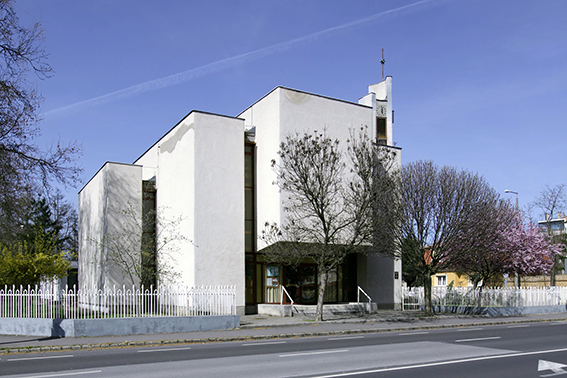Protestant Space-Continuity
Architectural–Structural–Liturgical Coherences of the Hungarian Protestant Church Architecture in the 20th Century
DOI:
https://doi.org/10.17979/aarc.2017.5.0.5146Keywords:
church architecture, protestant typology, modern architecture, centralised plan, HungaryAbstract
Intensive efforts started in the last decades to get to know the Central and Eastern European and the Hungarian church architecture. In this historically depressed period (1920/1945/1989), church buildings were important identity forming potencies in the life of the Protestant communities newly emerged by the rearrangement of country's borders. The modern architectural principles, the structural and liturgical questions gave opportunity for continuous experimentations in the examined period, which resulted a centralizing tendency between the two world wars. Analysing the Protestant space organization, it is verifiable that these centralizing tendencies with identification character did not pull out from the de-emphasizing church architecture in spite of the historical–political events of World War II. The primary importance of the study is the holistic examination of the Protestant church architecture of the 20th century. The study shows the Protestant Church activity of the period through the two most significant denominations —the Calvinist and the Lutheran church architecture—, thereby providing a typological approach.
Downloads
Metrics
References
Baku, Eszter. 2013. «Tradition and Liturgy. Centralising Tendencies of Lutheran Church Architecture in Hungary during the Interwar Period». Periodica Polytechnica Architecture 44/1:1-8.
Baku, Eszter. 2016. «Theory and Practice: Protestant church architecture beween the two world wars». Architectura Hungariae 15/3:133-146.
Bibó, István. 1985. «Der protestantische Kirchenbau in Ungarn um 1800». Mitteilungen der Gesellschaft für Vergleichende Kunstforschung in Wien 37/3:1-5.
Foltin, Brunó. 1992. «Az evangélikus templom». In Evangélikus templomok Magyarországon, edited by Dercsényi, Balázs and Brunó Foltin, Katalin G. Gyõrffy, Gábor Hegyi, Gábor Winkler, Zsuzsanna Zászkaliczky, 11-22. Budapest: Hegyi&Tsa.
Friedrich, Lóránd. 1944. «A Magyar evangélikus templom fejlõdése az újkorban». In Evangélikus templomok, edited by Lajos Kemény and Károly Gyimesi, 169-192. Budapest: Athenaeum.
Krähling, János, and Gergely Domonkos Nagy. 2009. «Late baroque greek-cross plan type Lutheran churches in Hungary». Periodica Polytechnica Architecture 40/2. 77-86.
Krähling, János. 2008. «A 20. századi magyarországi evangélikus templomépítészet a rendszerváltozásig». In Új evangélikus templomok, edited by János Krähling and Zorán Vukoszávlyev, 21-28. Budapest: Luther Kiadó.
Krähling, János. 2008b. «Gyülekezeti központok a XX. század szakrális építészetében». Építés-Építészettudomány 36/1-2:119-127.
Krähling, János. 2015. «The protestant church architecture of East-Central Europe in the seventeenth and eightteenth centuries: From medieval heritage to new spatial solutions». In Protestantischer Kirchenbau der Frühen Neuzeit in Europa – Grundlagen und neue Forschungskonzepte, edited by Jan Harasimowicz, 131-146. Regensburg: Schnell und Steiner.
Lõrincz, Zoltán. 2000. Ne hagyjátok a templomot: Új református templomok 1990-1999. Budapest: Kálvin Kiadó.
Medgyaszay, István. 1942. «Templomstílusok». In Református templomok Magyarországon, edited by János I. Kováts, 15-68. Budapest: Athenaeum.
Pecz, Samu. 1888. «A protestáns templomok építésérõl, kapcsolatban a debreceni kálvinista új templom részletes ismertetésével». A Magyar Mérnök- és Építész Egylet Közlönye 22:193-205, 241-251.
Ravasz, László. 1942. «A református templom». In Református templomok Magyarországon, edited by János I. Kováts, 1-4. Budapest: Athenaeum.
Mentzer Jr., Raymond A. 1999. «The Reformed Churches of France and the Visual Arts». In Seeing Beyond the Word: Visual Arts and the Calvinist Tradition, edited by Paul Corby Finney, 199-230. Cambridge: William B. Eerdmans Publishing.
Róka, Enikõ. 1996. «Pecz Samu Szilágyi Dezsõ téri református temploma és a protestáns centralizáló templomépítészeti hagyomány». Ars Hungarica 24/2:117-175.
Róka, Enikõ. 2008. «Centralizáló törekvések a protestáns templomépítészetben, Európa és Magyarország, 16-19 század». Régi-Új Magyar Építõmûvészet Utóirat 46:11-18.
Schnell, Hugo. 1974. Twentieth Century Church Architecture in Germany: Documentation, Presentation, Interpretation. Munich/Zurich: Schnell & Steiner.
Schulek, János. 1942. «Kísérletek új református templomstílus megteremtésére». In Magyar református templomok, edited by István J. Kováts, 339-349. Budapest: Athenaeum.
Sturm, Leonhard Christoph. 1712. Architektonisches Bedencken von Protestantischer Kleinen Kirchen Figur und Einrichtung. Hamburg: Schiller.
Sturm, Leonhard Christoph. 1718. Vollständige Anweisung alle Arten von Kirchenwohl anzugeben. Augsburg: Wolff.
Vukoszávlyev, Zorán. 2012. «Unifying the Community: The Evolution of Centralized Space in Hungarian Church Architecture 1900-2010». In Proceedings of the 2nd International Conference of the European Architectural History Network, edited by Hilde Heynen and Janina Gosseye, 364-365. Brussels: Koninklijke Vlaamse Academie van Belgie voor Wetenschappen en Kunsten.
Vukoszávlyev, Zorán, and Erzsébet Urbán. 2016. «Magyarország templomépítészete 1945–1964 között: Vázlat az alkotómûvészi értékeléssel megállapítható építészeti folytonosságról». Építés- Építészettudomány 44/1-2:247-315.
Vukoszávlyev, Zorán. 2016. «A 20. század hazai református templomépítészetének tendenciái: Egy tipológiai rendszer alapvetései». Architectura Hungariae 15/3:157-170.
















